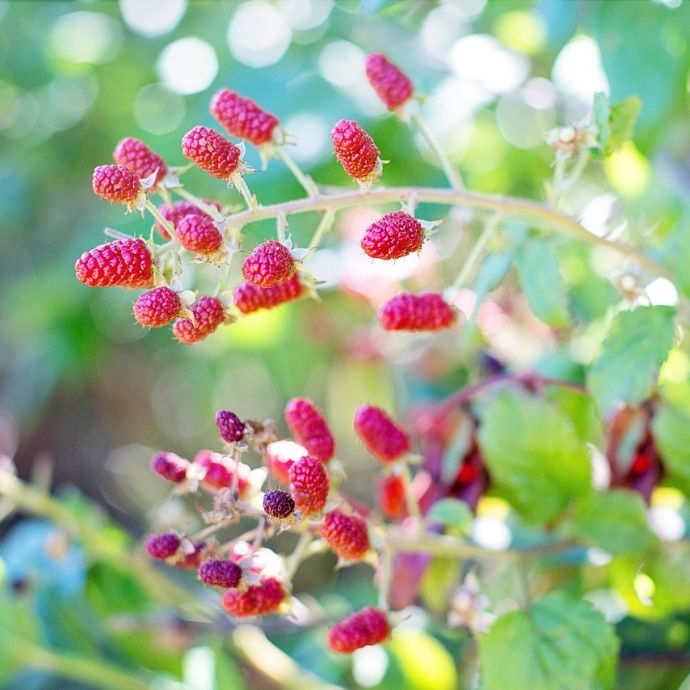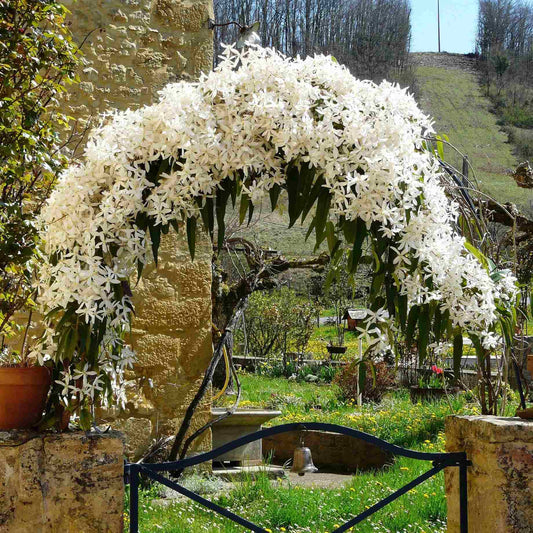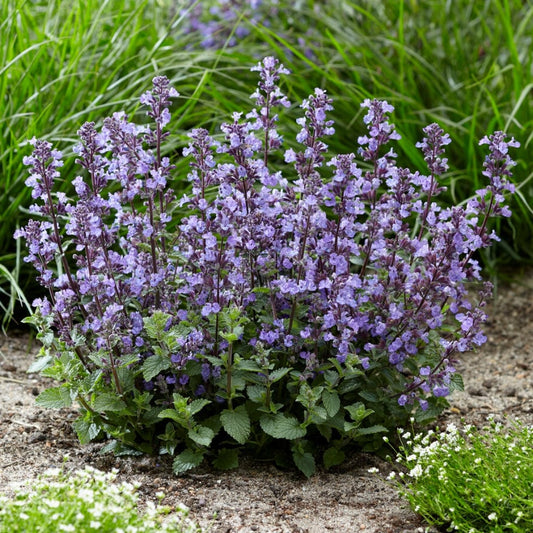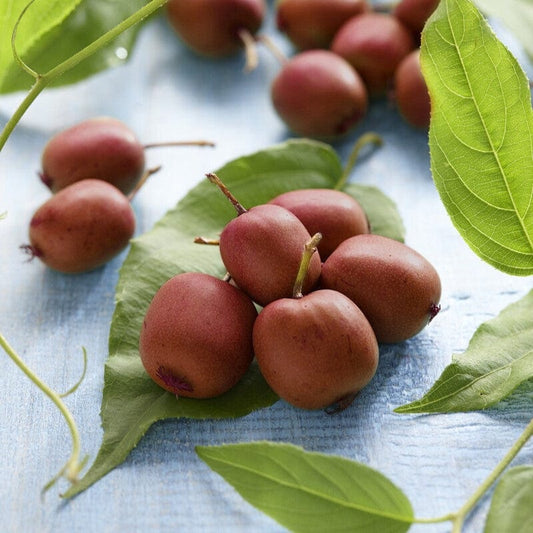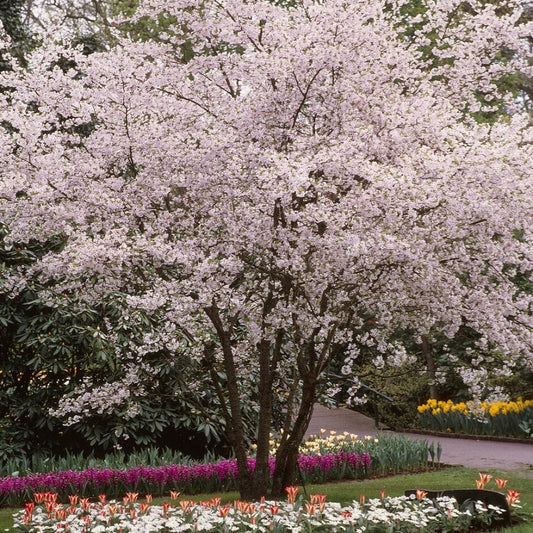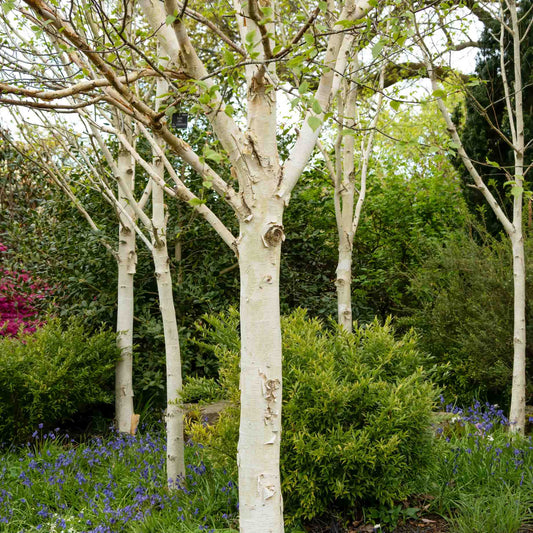Garden Jargon Buster: Gardening Terminology Explained
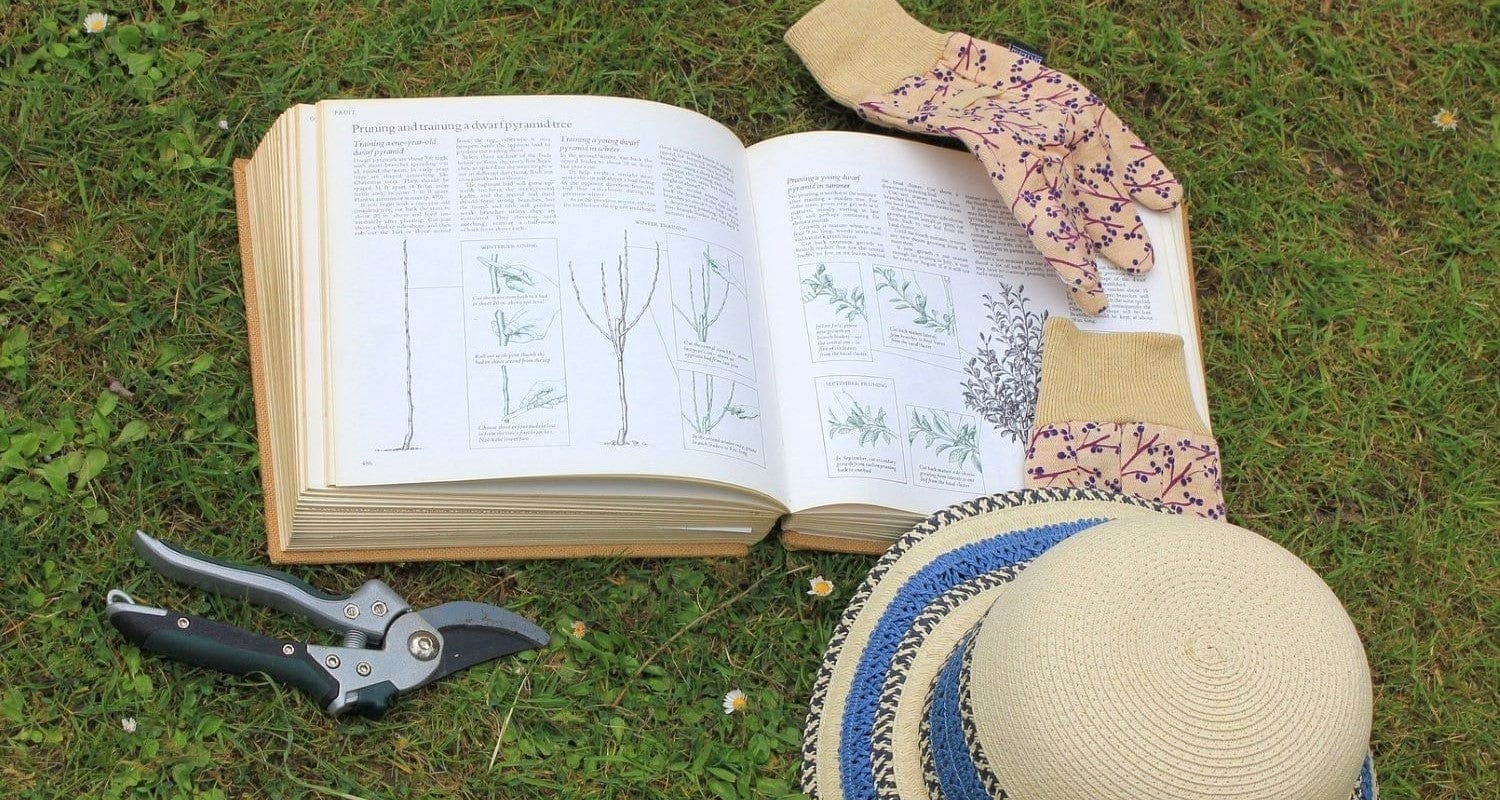
Chitting. Top dressing. Woody.
If you just muttered what the heck? or snorted with laughter, you’re in the right place. Gardening jargon can be weird and downright baffling to anyone who didn’t grow up in a greenhouse or spends their working day hoeing and heeling in.
I surveyed everyone at Roots HQ to find out which gardening terms used to mystify them (and still do if we’re honest), then asked our growers to explain. So here it is, our definitive list of baffling garden terms and phrases.
Memorising these will enhance your gardening, make you sound like a horticultural expert and boost your success rate at speed dating events. (Two of these things are true.)
Jump to: A - B - C - D - E - F - G - H - J - L - M - N - O - P - R - S - T - W.
Autumn vs spring planting
Most plants are best planted in spring, but some are fine to go in the ground in autumn and stay in the soil over winter. When you see ‘autumn/spring planting’ on a plant, that tells you the best time to plant it.
Annual
Annual plants complete their life cycle within one growing season. Put simply, they do their thing for a bit and then they die. You have to replace them every year. They’re not coming back. Let them go.
Acid & alkaline soil
Believe it or not, all soil is not equal. Some plants prefer acid soil and others alkaline, but most need something in the middle (neutral). That’s why you’ll see hardcore gardeners out testing their soil with pH testing kits. It’s actually kind of fun…
Bare root
Bare roots are plants that are dug up and sent to you while they’re dormant. It means they don’t have a pot or any soil around the roots and also makes them cheaper to buy. Winner.

Biennial
A plant that takes two years to complete its life cycle. So it grows in the first year, then flowers and sets seed in the second. A plant that plays the long game…
Bog garden
Maybe not what you’re thinking, this is a patch of boggy or waterlogged ground that’s made into a garden for plants that like that kind of thing. Often found at the edges of a pond or stream.
Bolting
AKA gone to seed. This happens when herbs and vegetable plants go wild, producing flowers and seed heads before they should. It’s caused by a sudden cold spell or change in the weather, and can be prevented with regular watering and planting out later.
Bulbs
Some plants store their energy underground while they’re dormant, in a short, fleshy stem called a bulb. They’re usually globe shaped and you can buy them for planting in autumn or spring.

Catkins
We’ve all seen them on trees in spring, but what are they? Catkins are flowers with long clusters of tiny petals or none at all. That’s because they’re pollinated by the wind so they don’t have to attract bees. Bees are not stupid, however, and still like to feed on them because they’re full of nectar.

Chalk soil
A very alkaline soil that can be sandy or heavy. Certain plants, such as cherry blossom trees, will not grow well in it, but others, such as clematis and lavender, will.
Chitting
This is something you do to seed potatoes to encourage them to grow lots of shoots. Put them in a tray in a cool, light place and watch them sprout - then plant them in the ground.

Image source: Flickr.
Clay soil
Ever broken your trowel trying to dig a hole? It might be clay soil. Wet and sticky in the summer, dry and cracked in the winter - most plants hate it so you’ll have to mix in some compost and grit.
Cloche
These are plant covers, used to protect young plants from cold weather or pests. Traditionally they’re bell shaped and made of glass, but you can get plastic ones too or make them out of bottles.
Companion plants
These are plants used to help out other plants - whether that's by keeping pests away, improving the soil or attracting pollinators. They’re usually planted next to vegetable or fruit crops.
Cold frame
A bit like a cloche, this is a low wood or metal frame with a glass or plastic roof and sides, used to protect plants from pests and bad weather.
Compost
Compost is made from rotted organic matter (food waste, old leaves, straw etc.) and used to grow plants in pots or to improve the soil in the ground. You can buy it or make your own.

Cordon
Cordons are plants (usually trees or vines) trained into a single main stem in order to save space in the garden.

Cutting
This is a piece of a plant that is cut off and put into compost or rooting gel to form roots and create a new plant.
Dappled shade
This is the kind of light you get in the woods, when it’s filtered through a leafy tree canopy, creating a ‘dappled’ effect on the ground. Woodland plants naturally thrive in this kind of light.
Deadheading
This means cutting or pinching off the heads of flowers that have finished blooming. It should be done regularly to encourage your plants to produce more flowers.
Deciduous
Deciduous plants are those which drop their leaves in autumn and grow new ones in the spring.
Dividing
The joyous art of getting new plants for free, this means cutting a part of your plant off when it’s getting too big for its space and planting it elsewhere to make a new one.
Dormant
We say that plants are dormant each year when they’re not in active growth. This usually takes place over the winter, from November to March.
Double, semi double and single flowers
Single flowers have one layer of petals surrounding an open centre, double flowers have several layers, often covering the centre of the flower and semi double flowers have more than one layer, but the centre of the flower is still visible (as illustrated here with cherry blossom).

Earthing up
This is done to plants like potatoes, celery and rhubarb in order to protect the growing stems, stop them going green, keep them stable or to blanch them (keep them white). It involves piling up soil around the base of the plant.
Ericaceous
Ericaceous plants are those that love acid soil, such as rhododendrons, azaleas and blueberries. If your garden soil isn’t acidic, you will need to use ericaceous compost.
Espalier
This is a space saving and highly aesthetic way of training a tree (usually a fruit tree) to grow horizontally against a wall or fence, with branches spaced apart like steps.

Evergreen
These are plants which keep their leaves all year round, often retaining their green colour. Semi evergreen means that in warmer areas your plant won’t lose its leaves, but in colder areas it may.
Feed or fertiliser
When we talk about feeding plants, we’re really talking about feeding (or fertilising) the soil so that it’s richer in nutrients that keep our plants healthy. Plant fertiliser can be a liquid, granules or powder and each plant has different feeding requirements.
Fertile soil
This is a soil full of nutrients that will allow plants to grow healthily.
Firming down/firming in
To firm in means to press down the soil around the base of a plant, usually when you’ve just planted it.
First and last frosts
The first frost of the year is when the temperature first sinks below zero overnight. It usually signals the end of the growing season, when flowers stop blooming. Similarly, the last frost signals the start of the new season in spring, when temperatures are not expected to fall below zero until autumn, and you can plant out your new plants. The first frost is usually in October and the last in May, but it depends on what area you are in.
Form
Plants come in different shapes, or forms, for example trees can be conical, vase shaped, spreading, round or pyramidal.
Full shade
Some plants (not many) will grow in full shade, which means that they get very little, if any light. Ferns, euphorbia and hostas will grow in these conditions, although they do better with a little light.
Full sun
Most fruit, vegetables and flowers grow best in full sun. This means that the plants are in a position where they get 6-8 hours of sunlight every day throughout the growing season (spring and summer).
Garden ready
We call plants garden ready when they’re big enough not to need any further potting on and are ready to be planted straight out into your garden or pots.
Grafted
Grafting is a process where parts of two separate plants are joined together to produce a stronger plant. It involves the top part of one being grafted onto the stem (or rootstock) of another. The new plant created will have the best qualities of both.
Gravel
We often advise you to add gravel to plant pots or to your soil to improve the drainage. Gravel is a mix of fine rounded stones that stops the soil getting too heavy and compacted, allowing more water to drain through it.
Groundcover
Groundcover plants are those which grow low down and close to the ground, spreading outwards. They help to keep out weeds and can be planted under trees, shrubs and taller perennials.
Grow bag/gro-bag
This is a plastic bag filled with compost which is used to grow plants, usually tomatoes. You cut holes in the top of it and plant directly into it. Grow bags are a useful way to grow in spaces without soil and can be more economical than buying containers, but can only be used once.

Image source: Mark Hilliary.
Habit
A plant’s habit is the way it grows. This can include clumping (forming clumps of foliage), climbing (growing upwards) or spreading (growing outwards).
Hardening off
This is a way of toughening up young plants before planting them outside, and involves putting them outdoors or into a cold greenhouse for increasing lengths of time, to get them used to colder temperatures gradually.
Hardy/half hardy
A plant’s hardiness level tells you what kind of temperatures it can tolerate without any harm to it. A fully hardy plant will be fine outdoors in any temperature and won’t need winter protection, whereas a half hardy plant will need to be brought indoors or protected over winter. You can find hardiness ratings on all our plant pages.
Heeling in
If you can’t plant your bare root plants in their final position straight away (for example, if the ground is frozen), you can heel them in. This means planting them temporarily in a soil trench or pot of compost until you’re ready to plant them permanently.
Herbaceous
This is a perennial plant which dies back to ground level at the end of summer and grows back the following spring. A herbaceous border is a border full of plants of this kind.
Horticultural fleece
It’s like a blanket for your plants. During the winter months, some tender plants will need protection from the cold, and we recommend covering or wrapping them with horticultural fleece. This usually comes on a roll and can be cut to size. Remove it when the weather warms up and save it for the following year.

Humus
Not to be confused with the chickpea-based dip, a humus rich soil is one that’s full of organic matter, including the rotted down remains of plants and animals. This enriches the soil, making it full of nutrients. Rather like the chickpea dip.
John Innes
Who is John Innes, and why does he have such a compost monopoly? Turns out he isn’t a brand, he was the 19th century founder of a horticultural research institute. The composts named after him are soil-based recipes formulated for propagating seeds (1), potting on seedlings (2) and mature plants (3), with fertiliser content increasing from 1-3.
Loam
Loam soils are rich, fertile and the perfect balance of every soil type. Plants love it and so will you - if you’ve got this soil type, you should probably never move house.
Mulch
Weird word, great concept. Mulching is the art of putting a layer of material on top of the soil around your plants in order to protect them from cold weather and weeds, and to improve their health. This can be anything from manure to bark chips, depending on the plant’s needs and what you want it to do.

Nutrients
Every plant needs a different combination of nutrients from the soil, so it’s important to check which are best for your plants. Most good soil or compost contains a good balance of nutrients, but if it doesn’t, or you want to give your plants a boost, you can add these with plant food. You might see letters like NPK on commercial plant food - here’s what that means.
- N = nitrogen. This is especially useful for brassicas and leafy greens and can be found in coffee grounds, chicken manure and nettles. Sounds like a Michelin star dish for sure.
- P = phosphorus is essential for healthy roots and can be found in mushroom compost (compost that has been used to grow mushrooms).
- K = potassium. This is good for flowering and fruiting plants, and can be found in comfrey and banana skins.
All plants need a mixture of these, but some need more of one and less of another - you can check on your plant’s nutrient needs by looking them up on our website.
Overwintered
Overwintering plants means bringing them indoors for the winter, to prevent them being damaged by extreme weather. They can then be taken outside again when the weather warms up in spring. Tender plants like citrus trees will benefit from overwintering.
Partial shade
Many plants that don’t need full sun will grow well in partial shade, such as heucheras, foxgloves and aquilegia. Partial shade means the plants are in a position where they get about 4-6 hours of sunlight per day during the growing season.
Perennial
These are plants that survive the winter and regrow the following spring, usually lasting for many years.
Perlite
Perlite is a useful addition to compost when you’re planting new plants, as it’s great for improving the drainage so that newly developing roots don’t get waterlogged. It looks like little bits of polystyrene but it’s actually made from heated and expanded volcanic glass.

Pest and disease resistance
You’ll see this on our plant pages. It tells you how likely a plant is to suffer from pest or disease issues. Low resistance means that a plant will be badly affected unless you take care to prevent issues, while high resistance means that your plant will be practically bulletproof.
pH levels
The pH level tells you how acid or alkaline your soil is, and therefore which plants will thrive in it.
The scale goes from 0 (most acidic) to 14 (most alkaline) so a pH level below 7 (neutral) is more acid and one above 7 is more alkaline.
Planting out
This means taking a plant that’s been grown indoors and planting it outside, usually in the ground.
Pinching out
This means removing some of the growth from the top of a plant by pinching it between your fingers, for example pinching out small shoots on tomato plants, which keeps the plant compact and avoids too much leafy growth at the expense of the fruit.
Plug plants
Plug plants are young seedlings that need to be potted on for further growth before being planted in your garden.
Pollination group
Unless a fruit tree or plant is described as self fertile, it will need a pollination partner to produce fruit. This means another tree of the same species but a different variety. Each variety of tree has a different pollination group number which you can find on their page on our website. You’ll need to pair it with a variety that has a number one up or down from that. For example, a cherry tree in pollination group 3 will need a partner in group 2 or 4.

Pot bound or rootbound
A pot bound plant is one which has no more room in its pot to grow. The roots will be tightly clumped together or spiralled round in the shape of the pot. It needs to be repotted in a larger pot or in the ground.

Image source: Flickr.
Potting on
Which leads us to this. Potting on simply means taking your plant out of the pot it’s in and replanting it in a larger pot so that it can continue growing.
Pricking out
When you’ve grown a lot of vegetable or flower seeds in the same tray, they will start to look crowded as they get bigger. This is when you need to prick out - carefully removing them from their tray and planting them in individual pots so that they can continue growing.
Pruning groups
Every plant needs to be pruned in a particular way at the right time of year to keep it growing healthily. This is where pruning groups come in - plants that have the same pruning needs are grouped together with a number so that you can look them up more easily and prune in the correct way.
Raceme
Many flowering plants (for example wisteria) are said to have racemes. This means that they have clusters of flowers with each flower growing on a short stem.

Rootstock
A plant’s rootstock refers to the root system with part of the stem attached. Fruit trees are grafted onto rootstocks of different sizes in order to create a tree of a certain size or with certain qualities, and you can find this information on all of our fruit tree pages.
Runners
These are the long, thin shoots that plants such as strawberries send out when they’ve finished fruiting - it’s how they reproduce. You can cut them off and use them to grow new plants.
Sandy soil
A sandy soil is very light, drains well and is easy to work with. However it tends to dry out quickly and nutrients wash out of it along with the water, so you may need to keep it topped up with plant feed more often, or mix in some compost.
Self fertile
A self fertile plant is one which produces fruit without a pollination partner. A lot of fruit trees now are bred to be self fertile, but they can still produce a bigger crop if teamed with another.
Self seeding
Self seeding plants like foxgloves and poppies spread by releasing their seeds to the wind and grow where they like! You’ll find them popping up in unexpected places in your garden, which is great if you’re aiming for a natural look (and yay, free plants!).

Shrubs
A shrub is a perennial plant with woody stems. It doesn’t die back in winter, but does put on new growth in the spring and so will need to be pruned.
Stamens
The stamens are usually in the centre of a flower, and are the part of the plant which contains pollen. They’re the plant’s male reproductive organs and are made up of a stalk or filament, with anthers (the bit with the pollen on).

Standards and half standards
A standard is a tree (usually small, often potted) pruned to one single main straight trunk with no lower branches to a height of 1.8m and a rounded top. They sometimes look like lollipops. A half or mini standard is a shorter version of the same thing, with the trunk clear of branches between 1.2 and 1.5m.

Image source: Humphrey Bolton.
Tender plants
These are plants that would be damaged by frost or cold weather if you left them out unprotected over winter.
Top dressing
Plants in pots need a constant supply of soil nutrients, but once they’ve used up all the goodness in their soil, they’ll need top dressing. This means that about once a year, you should add a layer of new compost to the top of the pot, which will renew the soil’s nutrients and keep your plants growing healthily.
Topiary
Topiary is the art of trimming trees, shrubs and hedges into shapes. You’ll mostly see geometric topiary - squares, balls and pyramids - in formal gardens, but spiral shaped trees are also popular and if you’re lucky you might find the odd peacock or reindeer.

Tuber
We talk about plants like dahlias and potatoes having tubers - these are a bit like bulbs in the sense that they store the plant’s food or energy underground over the winter while they’re dormant. Tubers look like a thick, fleshy root or stem and can sometimes be lifted out of the ground to store over winter, then replanted in the spring to regrow.

Image source: F D Richards.
Turning the soil
Into what, you may ask. It’s not that exciting. It simply means using a spade or a fork to churn the top layer of your soil in order to get air into it, break up any clumps and make sure the nutrients in it are evenly distributed.
Well drained soil
This is a soil that allows water to drain through it without becoming waterlogged. If a soil is too full of water, the plants’ roots can rot, so it’s important to keep it well drained. You can mix in perlite, gravel or sand to improve a wet soil.
Woody
If a plant’s stems are hard, rigid and brown (like wood), we describe them as woody. Unlike herbaceous perennials, woody plants like shrubs and some herbs don’t die back over winter - their old stems stay on the plant and should be pruned out regularly to encourage new growth.
Did I miss any? If there’s anything else you need to know (please keep it gardening related) just get in touch and we’ll ask our experts.
Last updated: 13/11/2023


